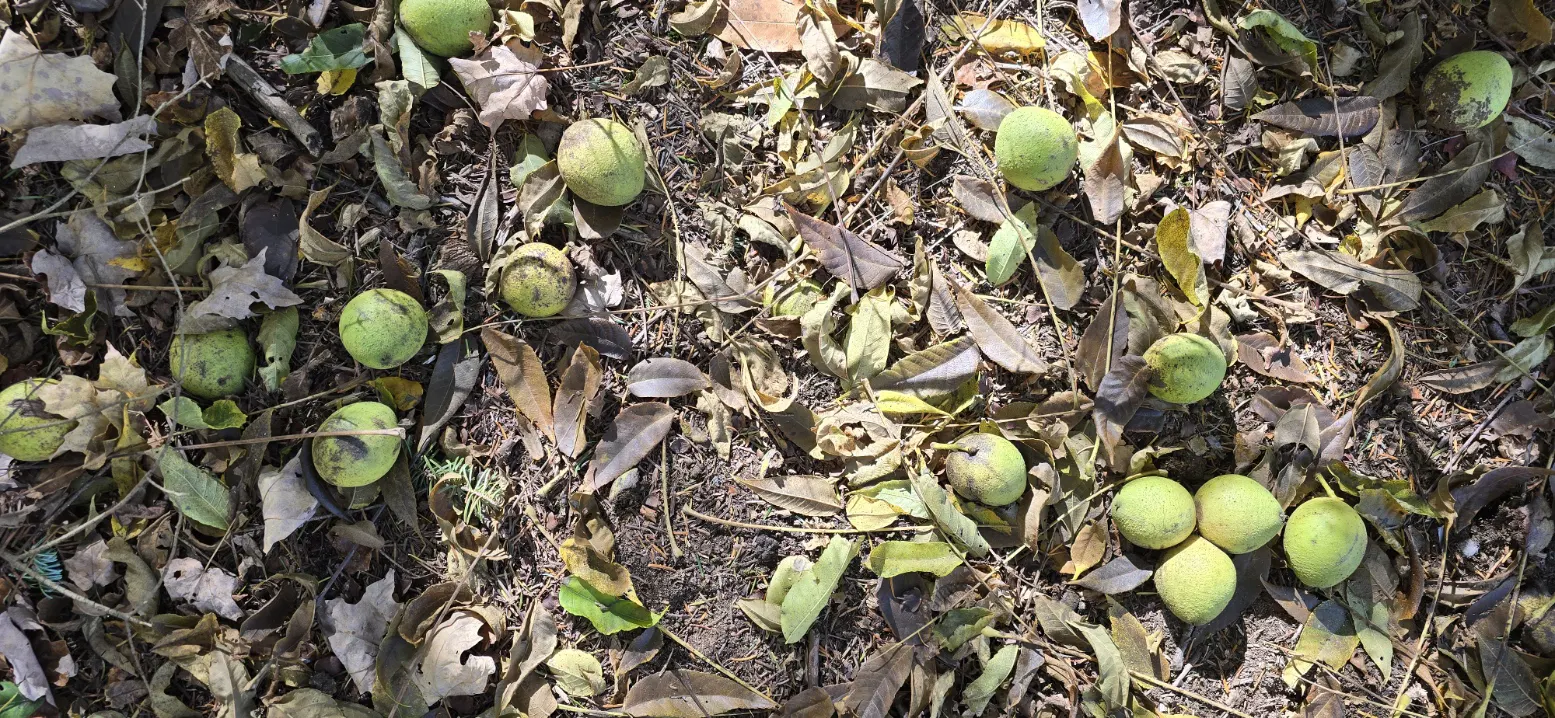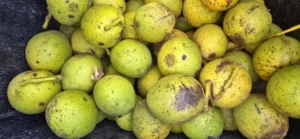
Introduction to Harvesting and Using the Raw Black Walnut
 Susan and I have two trees on our property that we believe are black walnut trees (Juglans nigra). This year, these trees have produced an exceptionally bountiful harvest, with more fruit falling to the ground than usual. Naturally, we began to wonder: can we harvest and use these walnuts? Are they even edible? And, are they truly black walnuts as we suspect?
Susan and I have two trees on our property that we believe are black walnut trees (Juglans nigra). This year, these trees have produced an exceptionally bountiful harvest, with more fruit falling to the ground than usual. Naturally, we began to wonder: can we harvest and use these walnuts? Are they even edible? And, are they truly black walnuts as we suspect?
The local squirrels seem to know the value of these nuts—they’ve been busy peeling away the tough outer husk to get to the good stuff inside. Interestingly, when the husks break open, they release a scent that reminds me of soap, which I later found out is due to a compound called juglone. If these nuts are indeed black walnuts, I’d love to figure out how to process and enjoy them. In the following sections, I’ll walk through what I’ve learned about identifying, harvesting, and making the most of black walnuts, including their health benefits and tips for processing them properly.
These trees are known for producing nuts with a thick, green, husky outer shell that squirrels love to feast on. The soap-like scent I mentioned is typical of the green husk when crushed, as it contains juglone, a compound that can have a sharp, earthy aroma.
Is the Black Walnut Edible?
Absolutely! Black walnuts are edible, and they have a rich, distinct flavor—earthier and stronger than English walnuts. The challenge lies in harvesting and processing them, as the husk and shell are extremely tough.
The following is a detailed guide on how to harvest and prepare the walnuts for use.
 Harvesting the Black Walnuts
Harvesting the Black Walnuts
- When to Harvest: Black walnuts fall to the ground in autumn, typically in September to October, just as they start ripening. Use caution, as they are not comfortable should you be hit by them when falling! And I don’t recommend parking under them when they are falling as they can leave dents. See my article on issues parking near them.
- Collecting Nuts: Gather the nuts soon after they drop to avoid mold or insect damage. The green husk will start to blacken as the nut ripens. You’ll be competing with the local squirrels for this!
Removing the Black Walnut Husks
- Protective Gear: Wear gloves since the husk contains tannins that can stain skin.
- Methods: You can:
- Use your boot to roll the nut on the ground until the husk comes off.
- Drive over the nuts with a car (on a hard surface) to break the husk.
- Use a vise or a simple nutcracker tool for larger quantities.
- Disposal of Husks: Compost the husks, but be cautious—juglone can inhibit some plants from growing.
Cleaning the Black Walnuts
- Rinse Thoroughly: After husking, wash the walnuts in water to remove any remaining debris. A bucket of water works well—discard any floating nuts, as they are likely bad.
Curing the Black Walnut
Curing allows the moisture inside the walnut to evaporate, which enhances the flavor and ensures a longer shelf life. While using the oven speeds things up, a slow drying process (like air-drying) often yields better-tasting walnuts.
- Air Drying: Spread the nuts in a single layer in a cool, dry area with good airflow. Leave them for 2-3 weeks to cure. This will help develop the nut’s flavor and reduce moisture.
- Oven curing: You can speed up the curing process for black walnuts using an oven, though it’s important to do it carefully to avoid compromising the flavor or texture. Here’s how you can safely cure black walnuts in the oven:
What You’ll Need:
- Black walnuts with husks removed
- Baking sheet or shallow tray
- Oven able to be set at 90-100°F (32-38°C)
Instructions:
- Preheat the Oven: Set your oven to 90-100°F (32-38°C). If your oven doesn’t go that low, use the lowest setting possible and leave the door slightly open to release excess heat.
- Spread the Walnuts: Place the walnuts in a single layer on a baking sheet. Ensure there’s enough space between them for airflow.
- Bake Slowly: Leave the walnuts in the oven for 12-24 hours, checking periodically to prevent them from getting too hot. Rotate the baking sheet occasionally for even drying.
- Monitor for Overheating: Make sure the internal temperature doesn’t exceed 100°F (38°C), as higher temperatures can spoil the oil content and degrade the flavor.
- Test for Readiness: The walnuts are cured when the shells feel dry and brittle, and the kernel inside sounds solid when shaken. You can also crack one open to check the texture.
- Cool and Store: Once cured, let the walnuts cool completely. Store them in an airtight container in a cool place, such as the fridge or freezer, to maintain freshness.
Cracking the Black Walnut Shell
- Tools: Use a hammer, vise, or specialized walnut cracker since black walnut shells are incredibly tough.
- Cracking Technique: Place the walnut on a hard surface and hit it firmly but carefully to avoid smashing the kernels inside.
Extracting the Black Walnut Kernels
- Patience Required: Use a pick or nut tool to extract the walnut meat from the hard shell. Black walnuts are more difficult to extract compared to English walnuts.
Storing the Black Walnut Kernels
- Storage: Keep the walnut meat in an airtight container. Store in the refrigerator or freezer to maintain freshness and prevent rancidity, as black walnut oils can spoil quickly.
Culinary Uses of Black Walnuts
- Use the kernels in baked goods like brownies, cakes, and cookies.
- Add to salads or sprinkle on top of yogurt and oatmeal.
- Make homemade walnut butter for a rich spread.
- Black walnuts can also be used to make flavored oils and liqueurs.
Processing black walnuts can be labor-intensive, but their unique flavor makes them a prized ingredient for cooking and baking. The squirrels seem to know their value, too, so you’ll need to act fast if you want to collect enough before they do! See our article here about using them in chocolate chip cookies.
Are Black Walnuts a Fruit or a Nut?
Botanically speaking, black walnuts are both a fruit and a nut. The term “fruit” refers to the mature ovary of a plant, which contains seeds. In the case of black walnut, the outer green husk is the fruit part. However, the nut is the hard shell containing the seed (kernel) inside. Once the fruit’s husk is removed, we are left with the edible nut, which is what people typically consume.
So in summary: Black walnuts are fruits, but we categorize them specifically as nuts, which are a type of fruit with a hard shell around the seed.
Health Benefits of Black Walnuts
Black walnuts offer several health benefits, thanks to their rich nutritional profile. Here’s an overview of their potential benefits:
1. Rich in Omega-3 Fatty Acids
- Benefit: Helps reduce inflammation, supports heart health, and improves brain function.
- Details: While fish is a primary source of omega-3s, black walnuts are a plant-based alternative.
2. High in Antioxidants
- Benefit: Protects against cell damage caused by free radicals, which may lower the risk of chronic diseases like cancer.
- Details: Black walnuts contain polyphenols and vitamin E, which are potent antioxidants.
3. Supports Heart Health
- Benefit: May lower cholesterol levels and reduce the risk of heart disease.
- Details: The combination of unsaturated fats, omega-3 fatty acids, and antioxidants helps improve cardiovascular health.
4. Source of Protein and Fiber
- Benefit: Promotes satiety, aids in digestion, and supports muscle repair and growth.
- Details: A small handful of black walnuts makes a filling, nutritious snack.
5. Supports Brain Health
- Benefit: Omega-3s and other nutrients in black walnuts may improve cognitive function and protect against neurodegenerative diseases.
- Details: These nuts contain alpha-linolenic acid (ALA), which is known to support brain function.
6. Anti-Inflammatory Properties
- Benefit: May help with conditions like arthritis and inflammatory bowel disease.
- Details: The oils and bioactive compounds in black walnuts have anti-inflammatory effects.
7. Contains Essential Vitamins and Minerals
- Key Nutrients:
- Magnesium: Supports muscle function and bone health.
- Potassium: Helps regulate blood pressure.
- Zinc: Boosts the immune system and supports healing.
8. Weight Management
- Benefit: May help control appetite and reduce cravings when eaten as part of a balanced diet.
- Details: The fiber, protein, and healthy fats promote feelings of fullness.
9. Gut Health Benefits
- Benefit: High fiber content supports digestive health and regular bowel movements.
- Details: Consuming fiber-rich foods like black walnuts encourages the growth of beneficial gut bacteria.
Potential Risks or Considerations
- Allergies: Black walnuts can cause allergic reactions in individuals sensitive to tree nuts.
- Juglone Toxicity: While safe to eat, the husks and shells contain juglone, a compound toxic to some plants and animals. Handling them can also stain your hands.
- Calorie-Dense: As with all nuts, black walnuts are high in calories, so portion control is key if you’re managing weight.
Incorporating black walnuts into your diet can be an excellent way to boost your intake of healthy fats, vitamins, and minerals. They offer multiple health benefits but, like all nuts, should be eaten in moderation.
